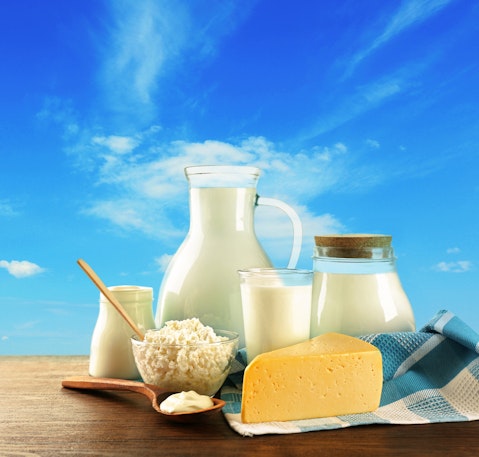In this article, we discuss the 15 biggest dairy companies in the world. If you want to read about some more dairy companies, go directly to 5 Biggest Dairy Companies In The World.
The daily consumption of milk is on the decline. Per the Economic Research Service (ERS) of the United States Department of Agriculture, the US daily per capita consumption of fluid milk has decreased over each of the past seven decades. Between 1990 and 2000, it fell from 0.78 cup to 0.69 cup per person, representing a decline of 11.5%. In addition, the increasing popularity of plant-based alternatives made from soy, almonds, and oats is also a contributing factor in the closure of dairy farms in the past few decades.
The US government estimates that from 2003 to 2018, US consumers of all ages drank less milk as a beverage, the primary way in which fluid milk is consumed. These dietary changes are not necessarily the healthiest. According to the Dietary Guidelines for Americans, individuals should consume 2 to 3 cup-equivalents of dairy products per day depending on their age, gender, and level of physical activity. Despite efforts made in this regard by dairy firms and the government, an astounding 90% of the US population does not meet these dietary targets.
A one-cup equivalent of milk translates to 1 cup of yogurt, 1.5 ounces of natural cheese, or 2 ounces of processed cheese. The ERS claims that the rise of the sweetened drinks and juices over the past few decades is not the most important factor with regards to the decline in dairy consumption, debunking a popular myth about the dairy industry. However, pricing, packaging, flavors, and nature of origin are some of the reasons why there is increased competition within the beverage industry.
Long-Term Outlook for Dairy Industry
Last year, the US government released long-term projections related to dairy consumption expected till 2030. These included several assumptions related to the Farm Bill, macroeconomic conditions, farm policy, and trade agreements. The report forecast that milk production would rise at a compound annual growth rate of 1.1% over the next 10 years, reaching 248 billion pounds in 2030. In 2030, milk cows are projected to amount to 9.43 million heads and milk production per cow is projected to average 26,295 pounds.
The report underlined that economies of scale trends were expected to continue, leading to further farm consolidation, as technological and genetic developments contributed to increasing yields. It also projected that by 2030, US dairy exports were expected to be 4.0% of milk production on a milk-fat milk-equivalent basis and 22.6% on a skim-solids milk-equivalent basis. The demand for butter and cheese was also forecast to rise in the next few years as the consumption of prepared food increased.
However, the decline in per capita consumption of fluid milk products is expected to continue. As feed prices rise, milk production continues to grow but starts lagging behind supply because of low milk prices and higher feed prices, the all-milk price is projected to increase in 2022. The prices will gradually dip to lower levels in between 2023 to 2025 and then increase in nominal terms later in the decade. Per the US government, the commercial use of dairy products is expected to rise faster than the growth in the US population over the next decade.
Short-Term Outlook for Dairy Industry
The government has been forced to raise the price forecasts for milk in 2022 and 2023 due to changes in dairy product prices, higher expected dairy exports, and lower expected milk production. The all-milk price forecast for 2022 is $25.45 per hundredweight, $0.25 higher than the forecast for the previous month. The all-milk price forecast for 2023 is $22.70 per cwt, $0.20 higher than the August forecast. Export forecasts have been raised as well due to strong demand from international markets and competitive US prices.
The domestic use of dairy is projected to be lower in 2023 because of weak demand trends in the US. The domestic use forecast for 2023 on a milk-equivalent basis is 221.2 billion pounds, 0.9 billion lower than the figure forecast in the previous month. On a milk-equivalent skim-solids basis, the forecast for domestic use is 181.4 billion pounds, 0.8 billion lower. Wholesale price forecasts for butter were raised on expected tighter supplies. The all-milk price forecast for 2023 was $22.70 per cwt, an increase of $0.20 from the previous month.
Investors looking to play these growth trends in the dairy sector should invest in some of the elite companies in the industry to reap handsome rewards later. Some of the top dairy firms in the US in 2022 according to hedge funds include The Hershey Company (NYSE:HSY), The J.M. Smucker Company (NYSE:SJM), and Eli Lilly and Company (NYSE:LLY). In addition to these, there are several dairy stocks based outside the US, some of which are mentioned below, that offer the same explosive growth potential.
Our Methodology
These were picked from a careful assessment of the dairy industry. The details of each dairy company are mentioned alongside a discussion around top firms in the sector in order to provide readers with some context for their investment decisions.

Africa Studio/Shutterstock.com
Biggest Dairy Companies In The World
15. Meiji
The first Japanese company on this list, Meiji, made $5.9 billion in revenue last year. It is one of the largest dairy and confectionery enterprises in the world, selling a variety of dairy products such as ice cream, cheese, and milk. In addition to dairy products, it also sells pizza and drinks. Meiji has a market cap of $6.25 billion.
Just like The Hershey Company (NYSE:HSY), The J.M. Smucker Company (NYSE:SJM), and Eli Lilly and Company (NYSE:LLY), Meiji is one of the top dairy companies in the world.
14. Sodiaal
Earning $5.7 billion in 2021, Sodiaal is a French dairy company on the list. Numerous Sodiaal brands, including Candia, Regilait, Entremont, and Yoplait, are well-known internationally. 17,000 different producers in France provide the raw materials for these brands. According to the company’s website, it was established in 1964 to accommodate the then-evolving tastes of French consumers.
13. Amul
Anand Milk Union Limited (AMUL) is a cooperative brand run by Gujarat Cooperative Milk Marketing Federation Ltd. (GCMMF), which was founded in 1946 and is now jointly owned by Gujarat’s 3.6 million milk producers. Amul entered the Rabobank Global Top 20 Dairy Companies list in August 2019, becoming the first dairy firm in India to be a part of the list.
12. Savencia Fromage & Dairy
With nearly 20,000 employees, this French dairy company made $6.6 billion in revenue. Savencia is famous for producing high quality cheese products. Their brands include Saint Agur Blue, Etokri, Saint Albray, and Alouette. Their sales growth was 13% in the first semester of 2022, of which 11% was organic. However, they suffered a 10% decline in current operating profit due to inflation.
11. Unilever
With more than 400 globally renowned and adored brands in a wide range of industries, Unilever is one of the most renowned and well-known corporations in the world. With over 300,000 workers worldwide and operations in over 190 nations, Unilever also has a significant presence in the dairy sector. $6.4 billion of the company’s overall revenue, which exceeds $50 billion, comes from the dairy sector. Last year, the company made $8.3 billion in the dairy sector. In recent years, Unilever started a Health and Wellbeing business whose turnover already reached €1 billion.
Alongside The Hershey Company (NYSE:HSY), The J.M. Smucker Company (NYSE:SJM), and Eli Lilly and Company (NYSE:LLY), Unilever is one of the best dairy companies to invest in.
10. Saputo Inc.
This Canadian dairy company made $12 billion last year. It has nearly 17,000 employees and operates in Canada, the UK, the US, Argentina, and Australia. Major brands include Alexis de Portneuf, Cathedral City, Friendship dairies, Sungold, and Dairyland.
9. Arla Foods
Arla Foods is the largest dairy company in Scandinavia and the UK, which generated $13.3 billion in revenue in 2021, and is based in Denmark. Lurpak and Castello cheeses are a few of the famous brands of Arla Foods. Don’t Cancel the Cow, an advertising campaign by Arla, claimed that the future of the dairy sector is questionable due to the rise of veganism among young people. The initiative aims to address young peoples’ worries about how cow milk affects the environment.
8. FrieslandCampina
The Dutch enterprise FrieslandCampina has 33 locations and almost 22,000 employees. After Campina and Friesland Foods merged in 2008, the firm was officially created. It significantly expanded in 2016 when it paid $450 million for a 51% share in Engro Foods Pakistan.
7. Mengniu Dairy
Mengniu’s primary products include ice cream and dairy products. With annual revenue of $13.7 billion, Mengniu is the main competitor of Yili group, as both are based in China.
6. Fonterra
Fonterra was established in New Zealand in 2001, when two largest dairy firms of the country merged together. They were Kiwi Co-operatives Dairies and New Zealand Dairy Board. Fonterra C0-operative Group Limited became New Zealand’s largest company and world’s sixth largest dairy company. In 2021, Fonterra made $14.8 billion in revenue. The market cap of Fonterra is $2.39 billion.
In addition to The Hershey Company (NYSE:HSY), The J.M. Smucker Company (NYSE:SJM), and Eli Lilly and Company (NYSE:LLY), Fonterra is one of the premier dairy companies.
Click to continue reading and see 5 Biggest Dairy Companies In The World.
Suggested Articles:
- 10 Best Cheap Dividend Stocks to Buy Now
- Top 9 Stock Picks of Eduardo Costa’s Calixto Global Investors
- 14 Best Casino Stocks To Buy Now
Disclosure. None. 15 Biggest Dairy Companies In The World is originally published on Insider Monkey.




